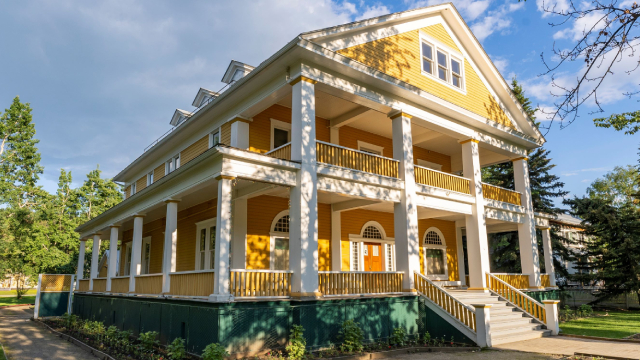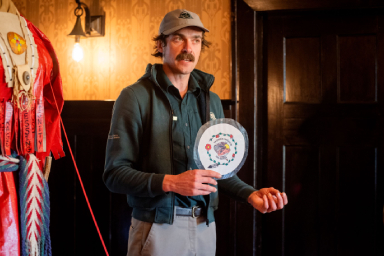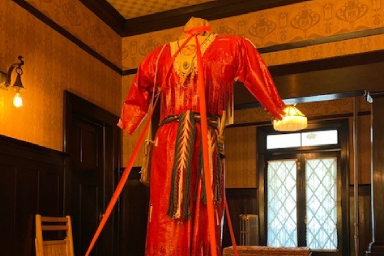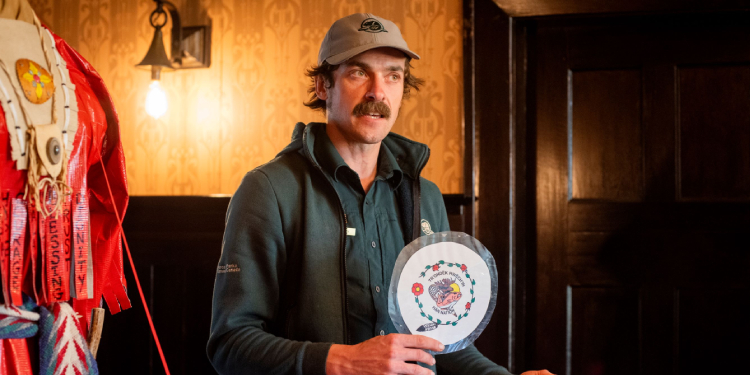
Renewed interpretation of the Klondike Gold Rush
Klondike National Historic Sites: a dress made of red tape highlights a renewed approach to historical interpretation in the Yukon.
Visitors to the stately Commissioner’s Residence in historic Dawson City, Yukon can experience a new guided tour about the lesser-known impacts of the Gold Rush. Through a collaboration with the local First Nation, Tr'ondëk Hwëch'in, Red Serge, Red Tape invites the public to consider voices that have historically been silenced and neglected, while inspiring action towards reconciliation.
Reinterpreting old symbols
The Commissioner’s Residence was built in 1901 as a Canadian symbol of elegance, permanence and stability. Part of Dawson Historical Complex National Historic Site, it is associated with the exercise of Canadian authority in the Yukon, and the imposition of colonial state power on Tr'ondëk Hwëch'in homelands.
Sharing a more inclusive story
A missing layer of history
Visitor tours in the Commissioner’s Residence originally focused on Klondike Gold Rush history from a settler perspective. The presence and role of First Nations peoples, when mentioned at all on the guided tour, was often only discussed in the context of pre-contact history. But Tr'ondëk Hwëch'in have ancestors in what is now the Yukon stretching back thousands of years. They had to cope with the arrival of tens of thousands of stampeders during the Klondike Gold Rush. Many Tr’ondëk Hwëch’in citizens live and work today in Dawson City.

Working together towards a broader understanding
Parks Canada and Tr'ondëk Hwëch'in began working together to renew the guided tour in 2016. In 2020, they co-hosted a three-day gathering for interpreters and Tr'ondëk Hwëch'in knowledge holders at Nänkäk Chʼëhòląy (“Land of Plenty”). That gathering provided Parks Canada staff with background knowledge and guidance to share Tr'ondëk Hwëch'in stories and perspectives during guided interpreted tours.
Different perspectives
The outcome of this collaboration is Red Serge, Red Tape, a visitor guided tour that addresses some of the difficult aspects of Yukon history. The interpretation still centres on the Klondike Gold Rush, but its focus is on how settler actions impacted Tr’ondëk Hwëch’in.
Visitors might be asked a question like “Who would--and wouldn’t--have felt welcome at the Commissioner’s Residence in the early 1900s?”
Once inside, visitors listen to a recorded conversation based on historical transcripts between Northwest Mounted Police Officer Charles Constantine and Anglican Bishop William Bompas. The conversation focuses on the Tr’ondëk Hwëch’in, who during the gold rush were displaced from Tr’ochëk, the heart of their territory at the mouth of the Klondike River. While Constantine and Bompas debated where the Tr’ondëk Hwëch’in should go, they decided for themselves, under the leadership of Chief Isaac, to relocate downstream to Moosehide. Guests are then asked a series of questions which encourage them to think about the Gold Rush from multiple viewpoints.
One of the most compelling interpretive elements is at the end of the guided tour, when visitors are shown a dress made of red duct tape designed and created by Métis artist Faye Chamberlain. The back of the dress includes written words associated with the negative impacts of colonialism and the Klondike Gold Rush such as “confiscation” and “dislocation”. By contrast, the front of the dress includes messages related to hope, such as “wisdom” and “empower”.
Art is a way for me to give a voice to my ancestor’s connection to the land, their suffering, their pride, and beauty as a nation.


As the guied tour concludes, visitors are asked how they might respond to the ideas discussed, and how they might make a difference in their own lives in support of reconciliation with Indigenous peoples.
- Date modified :

